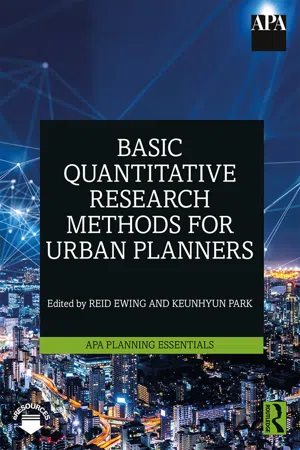
Basic Quantitative Research Methods for Urban Planners
- 328 pages
- English
- ePUB (mobile friendly)
- Available on iOS & Android
Basic Quantitative Research Methods for Urban Planners
About this book
In most planning practice and research, planners work with quantitative data. By summarizing, analyzing, and presenting data, planners create stories and narratives that explain various planning issues. Particularly, in the era of big data and data mining, there is a stronger demand in planning practice and research to increase capacity for data-driven storytelling.
Basic Quantitative Research Methods for Urban Planners provides readers with comprehensive knowledge and hands-on techniques for a variety of quantitative research studies, from descriptive statistics to commonly used inferential statistics. It covers statistical methods from chi-square through logistic regression and also quasi-experimental studies. At the same time, the book provides fundamental knowledge about research in general, such as planning data sources and uses, conceptual frameworks, and technical writing. The book presents relatively complex material in the simplest and clearest way possible, and through the use of real world planning examples, makes the theoretical and abstract content of each chapter as tangible as possible.
It will be invaluable to students and novice researchers from planning programs, intermediate researchers who want to branch out methodologically, practicing planners who need to conduct basic analyses with planning data, and anyone who consumes the research of others and needs to judge its validity and reliability.
Frequently asked questions
- Essential is ideal for learners and professionals who enjoy exploring a wide range of subjects. Access the Essential Library with 800,000+ trusted titles and best-sellers across business, personal growth, and the humanities. Includes unlimited reading time and Standard Read Aloud voice.
- Complete: Perfect for advanced learners and researchers needing full, unrestricted access. Unlock 1.4M+ books across hundreds of subjects, including academic and specialized titles. The Complete Plan also includes advanced features like Premium Read Aloud and Research Assistant.
Please note we cannot support devices running on iOS 13 and Android 7 or earlier. Learn more about using the app.
Information
1 Introduction
Overview
Quantitative Methods in Planning
Table of contents
- Cover
- Half Title
- Series
- Title
- Copyright
- Contents
- List of Figures
- List of Tables
- 1 Introduction
- 2 Technical Writing
- 3 Types of Research
- 4 Planning Data and Analysis
- 5 Conceptual Frameworks
- 6 Validity and Reliability
- 7 Descriptive Statistics and Visualizing Data
- 8 Chi-Square
- 9 Correlation
- 10 Difference of Means Tests (T-Tests)
- 11 Analysis of Variance (ANOVA)
- 12 Linear Regression
- 13 Logistic Regression
- 14 Quasi-Experimental Research
- List of Contributors
- Index